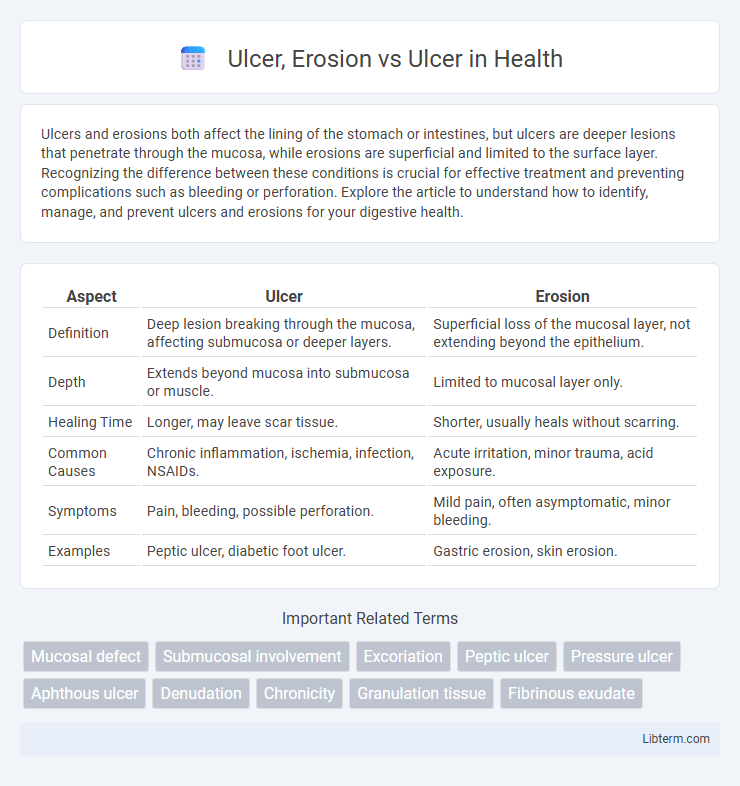Ulcers and erosions both affect the lining of the stomach or intestines, but ulcers are deeper lesions that penetrate through the mucosa, while erosions are superficial and limited to the surface layer. Recognizing the difference between these conditions is crucial for effective treatment and preventing complications such as bleeding or perforation. Explore the article to understand how to identify, manage, and prevent ulcers and erosions for your digestive health.
Table of Comparison
| Aspect | Ulcer | Erosion |
|---|---|---|
| Definition | Deep lesion breaking through the mucosa, affecting submucosa or deeper layers. | Superficial loss of the mucosal layer, not extending beyond the epithelium. |
| Depth | Extends beyond mucosa into submucosa or muscle. | Limited to mucosal layer only. |
| Healing Time | Longer, may leave scar tissue. | Shorter, usually heals without scarring. |
| Common Causes | Chronic inflammation, ischemia, infection, NSAIDs. | Acute irritation, minor trauma, acid exposure. |
| Symptoms | Pain, bleeding, possible perforation. | Mild pain, often asymptomatic, minor bleeding. |
| Examples | Peptic ulcer, diabetic foot ulcer. | Gastric erosion, skin erosion. |
Introduction to Ulcers
Ulcers are open sores on the skin or mucous membranes resulting from tissue destruction, often caused by infections, chronic irritation, or underlying medical conditions. Ulcerations penetrate deeper layers of tissue compared to erosions, which are more superficial losses of the epithelial surface without full thickness involvement. Understanding the distinction between ulcers and erosions is essential in diagnosing and managing gastrointestinal, dermatological, or oral mucosal conditions effectively.
Defining Erosion and Ulcer
Erosion refers to the superficial loss of the epithelial layer, typically affecting only the mucosa without penetrating deeper tissues, whereas an ulcer involves a full-thickness breach extending through the mucosa into the submucosa or deeper layers. Erosions often heal without scarring due to their limited depth, while ulcers may result in fibrosis or scarring during the healing process. Understanding these distinctions is crucial for diagnosing gastrointestinal conditions and determining appropriate treatment strategies.
Key Differences Between Erosion and Ulcer
Erosion refers to superficial damage to the mucosal layer of the gastrointestinal tract, often confined to the epithelial lining without penetrating deeper tissues, whereas an ulcer involves a full-thickness breach extending through the mucosa into the submucosa or deeper layers. Clinically, erosions tend to cause less severe symptoms and heal quickly without scarring, while ulcers may lead to complications like bleeding, perforation, and scarring due to their depth and tissue involvement. Diagnostic differentiation is based on endoscopic visualization, with erosion appearing as shallow lesions and ulcers presenting as deeper, crater-like defects.
Causes of Ulcers and Erosions
Ulcers are caused primarily by Helicobacter pylori infection, chronic use of nonsteroidal anti-inflammatory drugs (NSAIDs), excessive alcohol consumption, and stress-related mucosal damage. Erosions result from superficial damage to the mucosal lining often due to similar factors but are typically milder and limited to the epithelial surface. Both conditions involve disruption of the gastric mucosa, but ulcers penetrate deeper into the submucosa or muscularis propria.
Symptoms and Clinical Presentation
Ulcers typically present with deep, well-defined mucosal breaks accompanied by symptoms such as severe pain, bleeding, and possible signs of infection, whereas erosions involve more superficial damage to the mucosal surface, often causing mild discomfort and less pronounced bleeding. Ulcer symptoms may include persistent localized pain, weight loss, and anemia due to chronic blood loss, while erosions generally cause vague discomfort or dyspepsia without significant systemic signs. Clinically, ulcers are more likely to manifest with complications like perforation or strictures, whereas erosions usually heal without scarring and have a lower risk of severe outcomes.
Diagnostic Approaches for Erosion vs Ulcer
Diagnostic approaches for ulcer and erosion primarily involve endoscopic examination, where ulcers present as deeper mucosal defects penetrating the submucosa, while erosions are superficial mucosal lesions confined to the epithelial layer. Biopsy during endoscopy aids in differentiating benign ulcers from malignancies and assessing Helicobacter pylori infection status, critical for targeted therapy. Advanced imaging techniques like chromoendoscopy and magnification endoscopy enhance visualization, improving diagnostic accuracy between erosions and ulcers.
Complications Associated with Ulcers
Ulcers often lead to severe complications such as bleeding, perforation, and increased risk of infection, which can result in peritonitis or sepsis if untreated. In contrast, erosions are superficial lesions that typically do not penetrate deeply enough to cause serious complications, making them less likely to induce significant bleeding or perforation. Understanding the depth and severity of ulcers is crucial for timely intervention to prevent life-threatening outcomes.
Treatment Strategies for Erosion and Ulcer
Treatment strategies for erosion primarily focus on promoting mucosal healing using proton pump inhibitors (PPIs) and antacids to reduce gastric acid and protect the epithelium. In contrast, ulcers require more intensive management including eradication of Helicobacter pylori infection with triple therapy (PPI, amoxicillin, clarithromycin) alongside lifestyle modifications to prevent complications like bleeding or perforation. Both conditions benefit from avoiding NSAIDs and smoking cessation to support tissue repair and reduce recurrence risk.
Prevention and Lifestyle Modifications
Ulcers are deeper sores that penetrate the mucosal lining, while erosions are superficial breaks confined to the mucosa, making prevention crucial through lifestyle changes like avoiding NSAIDs, alcohol, and smoking. A diet rich in fiber, probiotics, and avoiding spicy, acidic foods supports mucosal healing and reduces ulcer formation risk. Stress management, regular exercise, and adequate hydration also contribute significantly to preventing ulcer recurrence and promoting gastrointestinal health.
Conclusion: Summary of Erosion vs Ulcer
Ulcers are deeper lesions that extend through the mucosa into the submucosa or muscle layers, causing more severe tissue damage and potential complications like bleeding or perforation. Erosions are superficial defects limited to the mucosal layer without penetration into deeper tissues, typically resulting in milder symptoms and faster healing. Understanding the depth and severity of tissue damage is critical for accurate diagnosis and effective treatment strategies in gastrointestinal disorders.
Ulcer, Erosion Infographic

 libterm.com
libterm.com